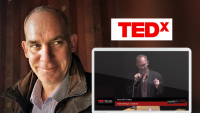Improving inclusivity of professionals who stammer

Dr Mobbassar Hassan Sk, Dept of Chemistry at the University of Cambridge, tells us what helps him deliver scientific presentations, and what can be done to raise awareness of stammering.
As a scientist with a stammer, I thought my own personal experiences and strategies to live with this challenge may motivate many others who might be struggling with it.
My Story
I recall having a stammer since I started speaking. In my school, when we were encouraged to get onto the podium to say a few words about a specific topic, I would force myself to volunteer. However, the strain and pain that I would go through during my speech would make me tired and sweaty in no time. This would be much worse when I would try to raise my voice to reach a larger audience.
Even today it is still the same. As a scientist, as one may imagine, I am often required to present my work to various audiences. At all stages of my academic career, starting at school and during my degree programs — bachelors, masters, PhD, and then as a post-doctoral researcher, I spent many sleepless nights before my presentations, thinking how I could possibly present with my stammer. I used to fall sick often due to this tremendous psychological pressure. I used to do breathing exercises to relax my muscles, which would be of some help during normal circumstances, but during the actual presentation none of these techniques seemed to work. From the very beginning of my talk, I would feel so tired due to the stiffness of muscles and forcing out words which got stuck inside my chest.
I spent many sleepless nights before my presentations, thinking how I could possibly present with my stammer.
After completing my PhD, I applied for a position but I was told that I couldn't be accepted because of my speech, even though my qualifications and background were well suited for it. Initially I used to think I needed to get rid of the problem, and questions always occupied my mind: why do I stutter? and where does this blockage originate from? I could hear my response being recited in my mind but couldn't verbalise it. I did whatever I could, but it never left me. Eventually, I accepted it and started living with it.
My techniques
Recently Nature (a scientific journal) published a letter I sent them all about the techniques I use to effectively present my scientific work. I wrote it so that others with similar difficulties can access them1.
In the letter, I explained how using a speech synthesiser (downloadable software, often free, eg 'Audiobookmaker', which reads your written words for you and can be customised the way you want) to deliver my talks helps audiences to engage easily (and ensures that I keep to the time limit). Using a laser pointer as the talk progresses helps to improve communication and it makes people focus their attention on what I am pointing to rather than me.
When answering questions from the conference floor, I find speaking directly works best — but I use keywords and phrases rather than full sentences. I back my answers up by simultaneously typing them onto a blank PowerPoint slide so that the audience can see them on the screen.
You can read my letter 'Communication tools for scientists who stammer' in full on the Nature website.
Challenges
It is much harder to climb the ladder with a speech disability.
In many cases, people who stammer leave education because of their struggle. I certainly understand that from the frustration, hardship, and challenges I faced to reach where I am today.
It is much harder to climb the ladder with a speech disability. Inevitably, the power of speech is a major component for professional growth. Without this it can be almost impossible to compete with professionals of the same calibre, unless some extra support and recognition are provided so that people who stammer are accepted, included and given whatever they need to fill that gap. In fact, that's the essence of equality, diversity, and inclusion (ED&I) practices. In every work sector, at least 1% of people should be accepted with speech disabilities.
Spreading awareness
Many efforts could be made. Some are already in place. An example would be publishing academic articles in prestigious journals (eg 2 and 3) to spread awareness about the complexity of the problem and ways to help (I responded to 2 myself), as well as my letter giving suggestions of techniques that I found to be very efficient. Organisations like 50 Million Voices and STAMMA focus on changing the professional world for people who stammer too.
As a part of our direct effort, we, as part of a stammering support centre in at Cambridge University, host monthly meetings in support of our departmental ED&I team. My own Chemistry department have shot my video clips to spread awareness about this challenge.
Stammering might never leave you, so, accept it, and find solutions to live with it. Spreading awareness about this apparently unseen disability is the key!
References:
- M Hassan Sk, Nature, 608, 266 (2022)
- Scandinavian Journal of Disability Research, 22(1), pp. 58
- E Sohn, Nature, 607, 197 (2022)
Read more Your Voice articles. Would you like to write about your experiences? See Submit Something For The Site or email editor@stamma.org for details.

































